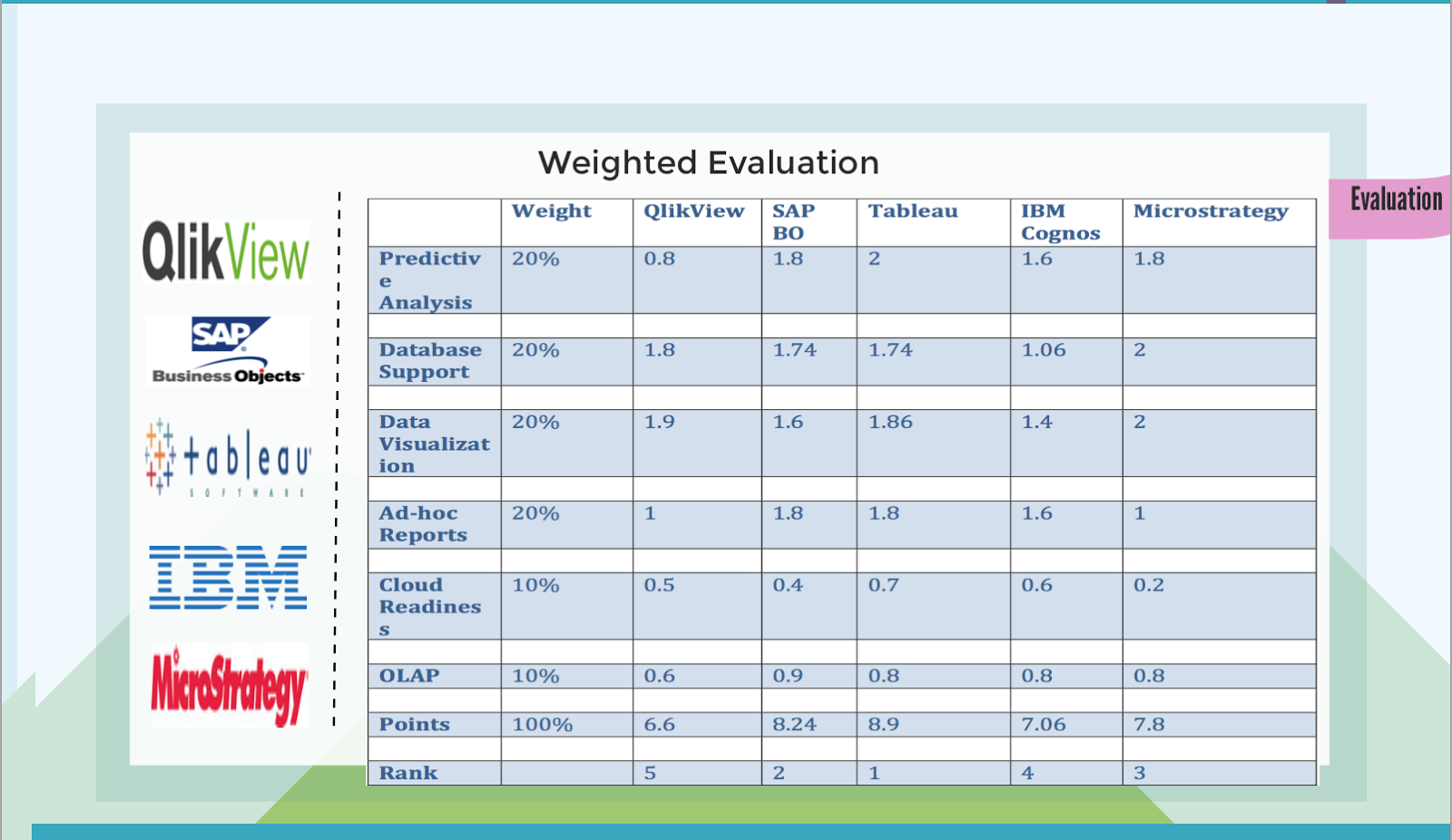 |
| TOOLS OVERVIEW |
 |
| EVALUATION CRITERIA |
 |
| WEIGHTED ASSESSMENT |
JUSTIFICATION FOR THE SCORES ASSIGNED:
Qlikview [Rank: 5]
Pros
Qlikview is a self-service access BI tool
built for non-technical professionals that utilizes both engaging graphics and
data consolidation from multiple sources into a single place to greatly
simplify data analysis. Qlik's in-memory processor vastly speeds up the
application and allows it to refresh in real-time, providing insights as data
is added. Qlikview distinguishes itself from other BI tools through its unique
inference engine, which maintains data associations automatically. Relationships
in data are easily illuminated with Qlikview’s visuals.
Cons
However, some businesses struggled with
end-users filtering and letting things unintentionally join, and either limit
or multiply the results. While a great feature, it is easily messed up at the end
user and developer levels. In general, some users struggled to grasp the
concept of filtering, and had trouble creating their own visuals.
SAP BO
Pros
SAP is for everyone - regardless of the
company size or industry. Anyone within a company, regardless of function, can
access any BI data via the SAP framework with no to minimal help from IT. SAP
has roughly 14 BI solutions that are aimed at different company sizes and
industries. For example, one BI solution is aimed at SMBs, while another
solution is geared toward companies that work with Microsoft Office. Other
solutions allows for the user to access their BI data via their mobile devices
or provide additional analytical features. Most BI platforms tend to be
specific to the company function (i.e. HR or sales) but the SAP’s
BusinessObject platform provides a broader solution. Users can perform BI
analysis from multiple data sources and in different formats.
Cons
The licensing process with SAP has proven
confusing for many users. Some have reported frequent support fee hikes, and
there are multiple levels of maintenance required on the program that build up
additional costs.
Tableau
Pros
Tableau is a streamlined, user-friendly
business intelligence solution that provides a simple, quick way for
non-experts to access data and create their own dashboards in just a few
clicks. The simplicity and clarity of the solution is provided without
sacrificing the depth and range of insight. Tableau also can produce very quick
results utilizing its rapid-fire intelligence tools that develop insights as
data comes in, in real time. Tableau Desktop relies on innovative technology
that allows users to click on data and drag and drop it where you want it so
that you can analyze exactly what you want. This makes connecting to data much
simpler for users, who can create dashboards in just a few moments. Also, Tableau
makes it easy to incorporate multiple data sources.
Cons
Tableau is currently working on adapting
their software for Mac. Some users have reported struggles with OLAP
calculations when working within Teradata, and have expressed frustration with
the ease of use of the tool. Essentially, Tableau has many advanced features,
and it can prove difficult to navigate between them.
IBM Cognos
Pros
IBM Cognos software is a business
intelligence tool that can be used to improve strategic management and monitor
financial performance. Cognos is unique for its scalable products that can be
tailored to the size of the business, ranging from the individual, a larger
workgroup, an entire department, a small business, or a major corporation.
Cons
Critics of the product cite its difficulty to
use, especially for those new to advanced software. Of particular note are the
error messages that continually pop up, and have been noted to be very
difficult to cipher and even more difficult to resolve. Data reports also take
almost twice as long to compile with Cognos as compared to most competitors.
Microstrategy
Pros
The MicroStrategy Analytics Platform
puts business intelligence in the hands of any user – meaning the user
will not need to rely on IT to provide analyses and reports. There’s no
complicated code to write or query to understand – just a click or drag and
drop. This platform also gives the end-user flexible deployment options; it can
either be hosted on site or in the cloud.
Cons
MicroStrategy users have noted that there is
a particularly steep learning curve to the technology. IT resources will need
to be devoted to help build up expertise within the user-base.
The tool also
operates within very rigid data structures, which may lead to more time spent
using Extract, Transform, and Load tools to get data in order.
The platform
does not include any predictive or prescriptive analytics tools, and some have
found the lack of more scientific visualizations frustrating.
 |
| MARKET USER SHARE |
 |
| VERDICT |

No comments:
Post a Comment